 We had several things to take care of this morning, so
didn’t go into Lisbon. One of the issues
was that during the rather rough seas last night, the lifeboats outside our
window were banging around. We were both
concerned that they hadn’t been secured properly after the recent lifeboat
We had several things to take care of this morning, so
didn’t go into Lisbon. One of the issues
was that during the rather rough seas last night, the lifeboats outside our
window were banging around. We were both
concerned that they hadn’t been secured properly after the recent lifeboat
 drills, so I reported that. (Can you
imagine how awful it would be to lose a lifeboat while crossing the
Atlantic? NOT what you want happening
while cruising!)
drills, so I reported that. (Can you
imagine how awful it would be to lose a lifeboat while crossing the
Atlantic? NOT what you want happening
while cruising!)
So today, Thursday 10 November, someone from Guest Services
called to  ask if things were better.
Yes, thank you, they were.
Someone apparently was sent to check and re-secured the lifeboats, so
the ropes aren’t swinging against the platform making noise all night. There’s still some creaking noises, but at
least things aren’t banging and thumping anymore. Yay!
ask if things were better.
Yes, thank you, they were.
Someone apparently was sent to check and re-secured the lifeboats, so
the ropes aren’t swinging against the platform making noise all night. There’s still some creaking noises, but at
least things aren’t banging and thumping anymore. Yay!
 In mid afternoon (of the
In mid afternoon (of the  9th), I headed out for
my excursion. I had signed up for
“Lisbon Baroque and the Art of Tiles.”
We started with a drive from our dock in West Lisbon to, well, somewhere
9th), I headed out for
my excursion. I had signed up for
“Lisbon Baroque and the Art of Tiles.”
We started with a drive from our dock in West Lisbon to, well, somewhere
 outside the
outside the  central part of the city. Our
guide gave us a brief history of Lisbon as our driver navigated our bus through
late afternoon traffic in downtown Lisbon, which
central part of the city. Our
guide gave us a brief history of Lisbon as our driver navigated our bus through
late afternoon traffic in downtown Lisbon, which  was a bit crazy. Lisbon dates back to the Phoenicians, who
were displaced by the Greeks, then the Romans, and on and on as various
invaders conquered this region.
was a bit crazy. Lisbon dates back to the Phoenicians, who
were displaced by the Greeks, then the Romans, and on and on as various
invaders conquered this region.
There was a large Muslim population living in the Iberian
Peninsula during the Middle Ages, but then with the Crusades they were
conquered by the Christians and returned to North Africa. However, the Muslims had decorated their
mosques with tile work, and taught  Portuguese artists and artisans all their
techniques for making tiles, decorating them, and using the tiles to embellish
and protect various buildings.
Portuguese artists and artisans all their
techniques for making tiles, decorating them, and using the tiles to embellish
and protect various buildings.
That’s a very brief history of how ceramic tiles became such a popular building surface in Portugal. Not only interiors, but exteriors of buildings are covered with decorative tiles, even to this day. We saw quite a lot of tiled buildings as we drove through the city.
 In 1755, there was a huge earthquake, tsunami, and then
fires that essentially wiped out the old city of Lisbon. Fortunately, buildings like the fortress were
on top of high hills, and many of the churches, monasteries, and convents were
outside the town and higher up on hills as well, so they survived this triple
disaster.
In 1755, there was a huge earthquake, tsunami, and then
fires that essentially wiped out the old city of Lisbon. Fortunately, buildings like the fortress were
on top of high hills, and many of the churches, monasteries, and convents were
outside the town and higher up on hills as well, so they survived this triple
disaster.
The Tile Museum is located in the former Madre de Deus (Mother
of G-d) Convent, which already had gorgeous blue on white tile work lining the
various open porticoes as well as the church and chapel inside. The museum now houses tiled panels dating
back to the 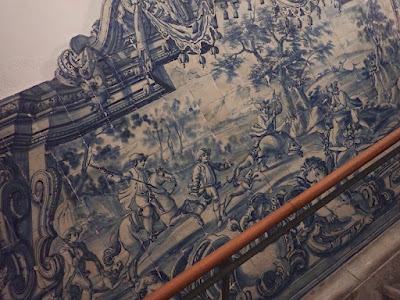 1500s, as well as examples of how the actual tiles were made.
1500s, as well as examples of how the actual tiles were made.
It was GORGEOUS!!! One
panel of tile was more gorgeous than the next!
It was interesting to see the changes in design and style through the
ages, as well as the changes in color as new chemicals were 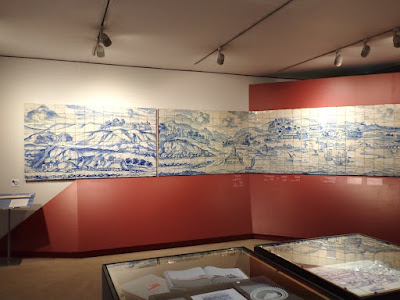 discovered. Really, this was artist heaven!!!
discovered. Really, this was artist heaven!!!
I should add that these are mosaic murals, but not in the traditional sense where tiles are cut into shapes to create the images. In Portuguese murals, square tiles are used, and the  images are painted in glaze on the tiles, then fired in the kiln. So the image is painted, rather then being made by various colored tiles cemented onto the wall. Much easier to get fine details with a paintbrush!
images are painted in glaze on the tiles, then fired in the kiln. So the image is painted, rather then being made by various colored tiles cemented onto the wall. Much easier to get fine details with a paintbrush!
The original Muslim tile panels showed geometric  designs, in
keeping with the belief to not make graven images, including anything from the
plant or animal kingdom. However, once
the Christians began making tile panels, the panels featured different stories
of saints, the life of Jesus or Mary, all that, as well as historic
panels. The church was full of religious
tile work. (The convent
designs, in
keeping with the belief to not make graven images, including anything from the
plant or animal kingdom. However, once
the Christians began making tile panels, the panels featured different stories
of saints, the life of Jesus or Mary, all that, as well as historic
panels. The church was full of religious
tile work. (The convent  was redecorated
in the 18th century, so I don’t really know what was original to the
convent, and what was part of that redecorating effort.)
was redecorated
in the 18th century, so I don’t really know what was original to the
convent, and what was part of that redecorating effort.)
And then the chapel upstairs. The tile on the walls was gorgeous, but the
room was full of little niches holding reliquaries.  I just can’t get beyond knowing that this
relic is supposed to be the finger of Saint X or the tooth of Saint Y or the hair
of Saint Z. It just freaks me out, and I
really can’t deal with it. So I walked
in, saw one or two reliquaries, and had to leave. Just way too creepy.
I just can’t get beyond knowing that this
relic is supposed to be the finger of Saint X or the tooth of Saint Y or the hair
of Saint Z. It just freaks me out, and I
really can’t deal with it. So I walked
in, saw one or two reliquaries, and had to leave. Just way too creepy.
 The stairs were very funny, though! The murals were obviously painted to be horizontal, rather than on a diagonal. So the tiles were cemented on as diamonds, and the scenes made little sense running uphill at a 45 degree angle! Because the trees, people, everything were not quite upright vertically, so everything looked like it should be
The stairs were very funny, though! The murals were obviously painted to be horizontal, rather than on a diagonal. So the tiles were cemented on as diamonds, and the scenes made little sense running uphill at a 45 degree angle! Because the trees, people, everything were not quite upright vertically, so everything looked like it should be  falling or rolling downhill!
falling or rolling downhill!
The top floor houses the 24 meter long (over 75 foot) tile
mural showing what Lisbon looked like prior to being wiped out by the earthquake-tsunami-fire
triple disaster. Again, incredible. So detailed, and it was impossible to see the
entire mural all at  once, it’s so long.
Only about 1.3 meters (4 feet) or so high, but so long! This "Panoramic View of Lisbon, The Bairro do Mocambo" as it is titled, was created by Gabriel del Barco of Lisbon in the early 18th century. (Overview photos here, close up photos of details at the end.)
once, it’s so long.
Only about 1.3 meters (4 feet) or so high, but so long! This "Panoramic View of Lisbon, The Bairro do Mocambo" as it is titled, was created by Gabriel del Barco of Lisbon in the early 18th century. (Overview photos here, close up photos of details at the end.)
 I overheard two men talking about some visual discrepancies
in the mural, where tiles were cut in different sizes than all the surrounding
ones, or where the drawing seemed to stop and restart. Ceramics was my area of concentration in art
education school, so I started chatting with them. We agreed that the mural
I overheard two men talking about some visual discrepancies
in the mural, where tiles were cut in different sizes than all the surrounding
ones, or where the drawing seemed to stop and restart. Ceramics was my area of concentration in art
education school, so I started chatting with them. We agreed that the mural  was likely made for
a different space originally, so that might explain the tile size issue.
was likely made for
a different space originally, so that might explain the tile size issue.
Another reason might be that large slabs of clay were rolled out and painted with portions of the mural, then cut into the tiles. (Rather than cutting out the tiles, lining them up, and  painting the pictures.) Cutting one large slab might have caused some sections to be sized differently, if the person doing the cutting didn't plan well.
painting the pictures.) Cutting one large slab might have caused some sections to be sized differently, if the person doing the cutting didn't plan well.
We talked about how possibly different artists worked on different portions of the mural, and maybe transitions from one artist’s area to another might have needed some improvisation to cover where things didn’t quite line up. Or perhaps what looked odd was that the perspective wasn’t accurate in our modern way of drawing perspective.
It turned out that one of the men was a professional ceramicist, and we also talked about the difficulties in making tiles and ensuring they dry and fire perfectly flat. As well as what kind of clay may have been used (we agreed it wasn’t porcelain), and how using cobalt to get this deep blue color can be problematic. We both agreed that the clay and glazing was fired at a low to medium heat, only 900 to 1000 degrees Celsius.
Interesting discussion, to talk about the technical aspects with someone else who had professional experience working in clay!
Well, then it was time to leave. But my mango allergy medications hit me at that point – steroids are such strong meds! I was suddenly ravenous and shaky, a bad combination. So I ran into the coffee shop and bought a café con leche to go, plus a little traditional pastry, a custard tart. Of course, it took a minute for the barista to realize he didn’t have a lid for the to-go cup, and to find a paper bag for my tart. By the time I made it outside, snack in hand, I couldn’t find the bus! I still had the tour guide’s little speaker device and ear bud in, but I couldn’t hear anyone speaking! Uh oh!
Our guide had previously shown us where to meet the bus, by the side door so I turned and rushed up the street. There was the bus, but it was holding up traffic. As I approached, the driver had to pull up and eventually pull over! ACK! It isn’t easy to run with an open coffee cup, nor two days after an anaphylactic episode! I did my best, but yes, I was that person who shows up 5 minutes late. I apologized to our guide and driver, and rushed to an available seat. Whew!
Traffic was crazy as we drove through another part of central Lisbon, and our guide and driver realized the problem was that there was a big football (soccer) match that evening. Everyone was rushing home to get ready to watch the game. But as the sun set and the city lit up, we continued on our tour, heading to the Basilica da Estrela (Of the Star?) church, an example of Baroque architecture. Baroque architecture is from the 17th to 18th centuries, and tends to be overly ornate, at least to our modern taste. But the Basilica da Estrela actually wasn’t too overly decorated, at least compared to some cathedrals like the one in Orvieto (Italy). The exterior was classically white, with spires and campanile (bell towers), and statues. The interior was decorated with bas relief marble pillars and various colored marble or stone panels, rather than every inch being painted. There were paintings behind the altar, and huge white marble statues above the altar and at each end of the apses or transepts or naves. (Church architecture is not my speciality, that’s for sure.)
Anyway, it was a fairly calm church. I know, it’s technically a basilica, which is higher in the church hierarchy, but again, this isn’t my area of specialization nor interest. I liked the exterior better than the inside, but at least it wasn’t that overwhelming kind of church. It had a quiet, mellow, spiritual kind of feel, which was nice.
Even the sidewalks were interesting! They were the black and white stone designs we've seen in other former Portuguese colonies, sort of a mosaic sidewalk!
And then we had a fairly short drive back to the ship. By then, the sun was down and it was 6:30 PM or so, the street lights and signs were all lit up. Things had cooled off a bit, definitely sweater weather. But it had been a fun tour, learning about the history of tile in this country, as well as seeing the city light up as evening fell.
Tomorrow is a sea day, then the Azores!
Tons of photos to follow. The tiles were all so gorgeous, I just couldn't stop taking photos. For my fellow artists and art teachers, enjoy. To all the people who get bored with lots of photos, take a glance and then move on to something else. I know, not everyone loves ceramic tiles. But some of us do, so here you go. (Views of driving through Lisbon are first.)









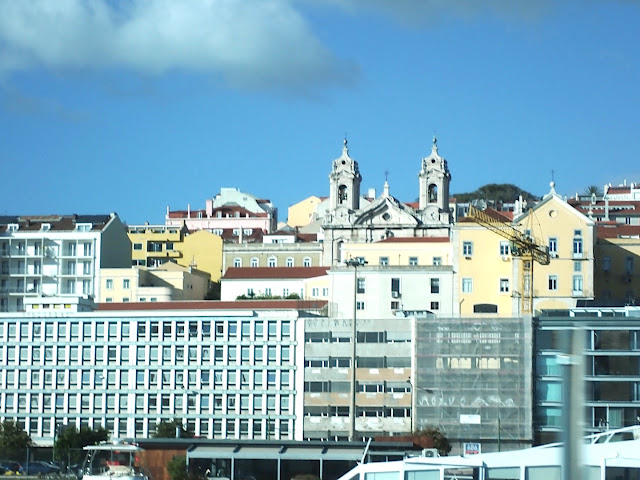











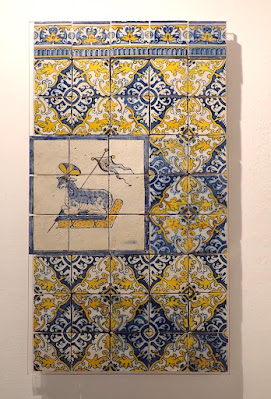
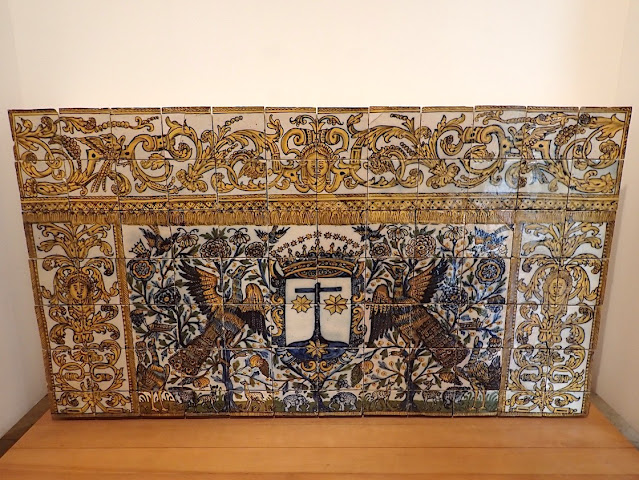











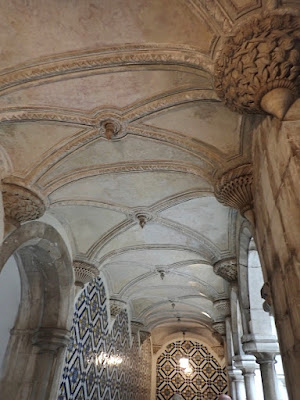














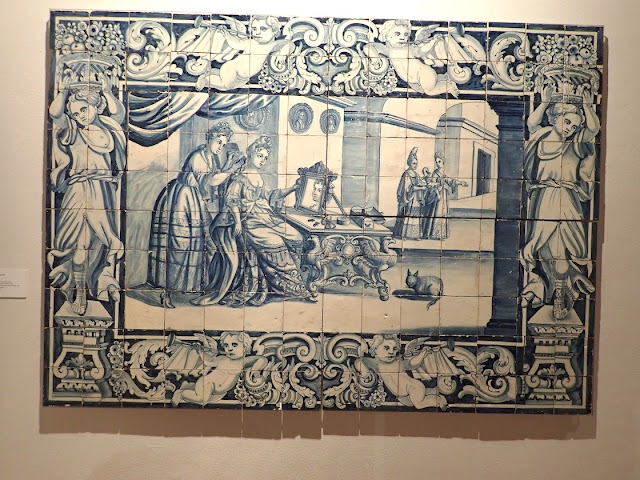




















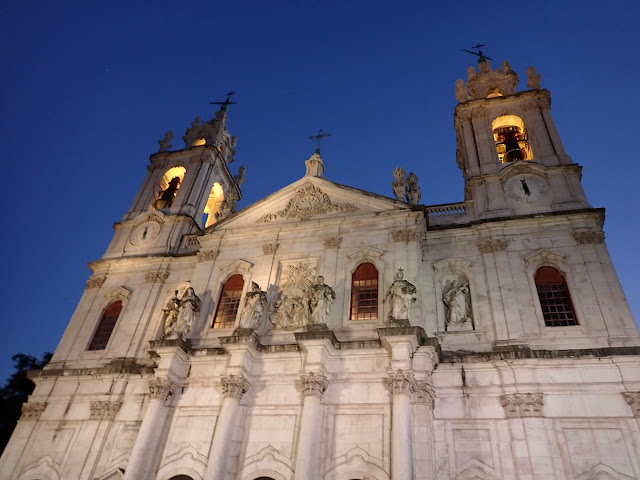



What beautiful, beautiful tiles. And nice you got to talk about it w/professionals.
ReplyDeletehugs
barb
1crazydog
Breath-taking photos and another amazing adventure in learning (for me), and professional kibbitzing (for you). Thanks again.
ReplyDelete